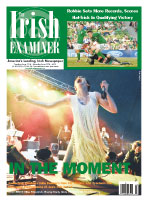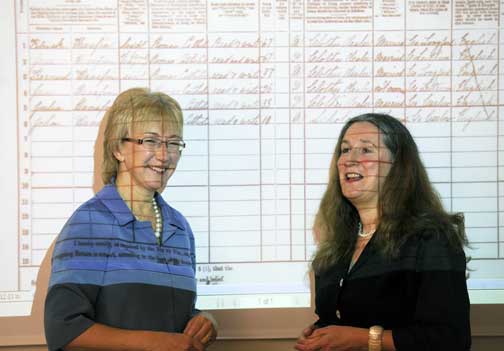


SERVICES
Tuesday June 8, 2010
Hanafin Launches Full 1901 Census Returns Online
Minister for Tourism, Culture and Sport, Mary Hanafin (left) and Head of Special Projects at the National Archives, Catriona Crowe, pictured at the launch of the full 1901 Census returns online at th National Archives in Dublin (Photocall) Last Thursday, Mary Hanafin T.D., Minister for Tourism, Culture and Sport launched the website containing the full 1901 Census of Ireland Records at the National Archives in Bishop Street, Dublin. Over 4.5 million individual records from the returns made by some 850,000 households on census night in 1901 are now available free of charge for everyone across the world to access. Minister Hanafin said "these records, conserved and held in the National Archives, represent an extremely valuable part of the Irish national heritage. They are a fascinating resource for genealogists, local historians and other scholars and everyone who has an interest in tracing their heritage and roots." The Irish Census returns for the night of Sunday 31st March 1901 provide detailed returns from households across 32 counties of the island of Ireland and are the earliest surviving complete government census returns. The vast bulk of earlier census returns were destroyed over time with many records lost due to a fire in 1922 at the Public Records Office. The 1901 Census online returns are easy to read, with returns usually covering just one page per household containing details under the following categories - first name, surname, relation to head of family religious profession, education, age, sex, rank/profession or occupation, marriage status, where born, whether the individual spoke Irish or English or both and if an individual had a disability. Examining some of the online records at the National Archives, Minister Hanafin said "along with the 1911 full census, which is also available online and covers the island of Ireland, this new addition to the website is an excellent source both for the history student and the genealogical researcher. The Irish diaspora now stretches to an estimated 70 million people across the world, the prospect of being able to trace your forefathers back to their home country, town, village and even street is now at your fingertips. It is also a fact that many people use the census as a starting point for cultural tourism, which has immense potential to increase numbers visiting all parts of Ireland." The returns are a principal source for Irish social and economic history in the early twentieth century. Just a few of the names which stand out include that of:
The Department of Tourism, Culture and Sport allocated some €3.78 million to the digitization project. Over the past five years the National Archives of Ireland has, through a research partnership with Library and Archives Canada managed and facilitated digitization, indexing and contextualisation of the 1901 and 1911 census records. The first phase of the project, Dublin City and County 1911, was launched in December 2007. |
CURRENT ISSUE

RECENT ISSUES


SYNDICATE
[What is this?]
POWERED BY

HOSTED BY

Terms of Service | Privacy Policy
Website Design By C3I






